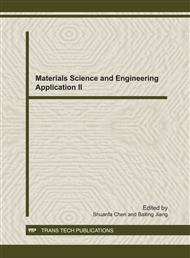p.174
p.180
p.184
p.190
p.195
p.201
p.207
p.213
p.217
Nitrogen Concentration in N-Implanted Gold on the Formation of Gold Nitride
Abstract:
Although gold nitride has been produced by Siller and co-workers by irradiating a gold film with low energy nitrogen ions, the unsuccessful reason for previous attempts to produce gold nitride is not clear yet. In general, nitrogen concentration depth profile probably influences gold nitride formation. But it is difficult to measure nitrogen concentration depth profile in the N-implanted layer at a low implantation energy of 500 eV. Ion concentration depth profiles in amorphous solids can be determined rather accurately in the case of low implantation fluences using TRIM code. The sputtering effect of ion implantation of high fluences on the concentration depth profile of implanted nitrogen ions should be considered. A dynamic computer simulation based on a TRIDYN code has been applied to calculate nitrogen concentration depth profile in a N-implanted gold film using the different parameters of the fluence and energy in the present work. The sputtering effect of a high fluence on the concentration depth profile can be considered in the TRIDYN simulation. The parameters of fluence and energy that enable to get the gold nitride in thin film are analyzed based on the simulation results. It is put forward some possible ways to improve the formation of gold nitride further.
Info:
Periodical:
Pages:
195-200
Citation:
Online since:
December 2011
Authors:
Keywords:
Price:
Сopyright:
© 2012 Trans Tech Publications Ltd. All Rights Reserved
Share:
Citation:


